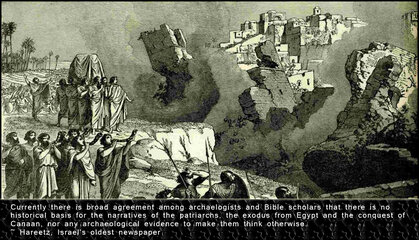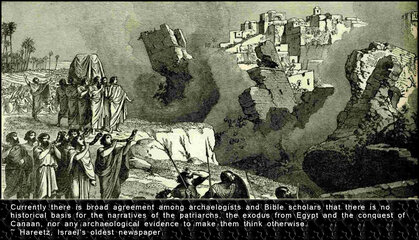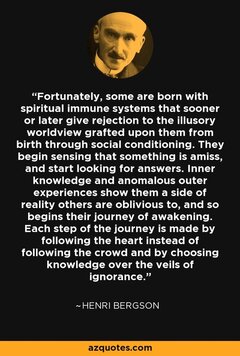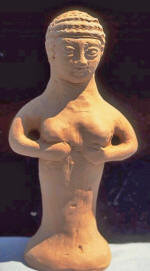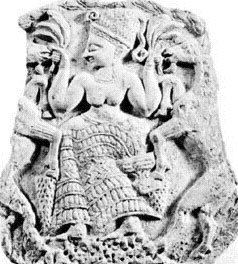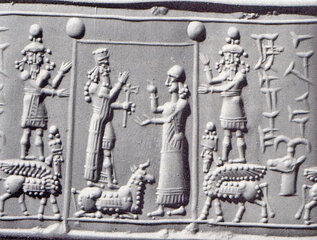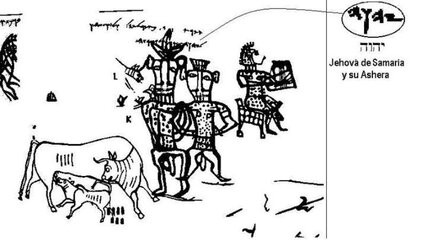- Messages
- 2,145
- Reaction score
- 5
- Points
- 28
Deconstructing the Walls of Jericho:
Archaeological Missions Fail the Biblical Narrative
by Ze'ev Herzog

Archaeological Missions Fail the Biblical Narrative
by Ze'ev Herzog
Summary:
- Rather than contradicting earlier European findings as initially intended, the biblical archeological missions instead turned out to support the opposite claims it wanted to refute in the first place.
- One of the first to be confirmed is the revelation that the god of Israel is derived from earlier gods and he in fact has a consort or a wife in Asherah, who is also identified with an earlier goddess related to other gods and goddesses of other cultures.
- The Exodus is a total fabrication: never in any period of history did the Israelites stay in Egypt under any capacity, either as slaves or subrulers.
- The Israelites identify with the former rulers of Egypt, the Hyksos, who were the ones driven out of Egypt.
- The whole 40 years episode in the wilderness is a total fabrication.
- There was no parting of the Red Sea.
- The Israelites did not conquer the Canaan as the bible heroically depicts.
- King David and King Solomon did not exist or if they did, they were at best minor tribal rulers of Canaan.
- The story of the patriarch Abraham and others are fictional legends with no historical equivalents.
- The findings are well-known for many years through many fields, but conveniently ignored in Israel and in Islamic and Christian traditions for the obvious reason of the cataclysm it would bring about. In the Palestine, it threatened to jeopardize the "historical" claims of the state of Israel to “their” land.
Following 70 years of intensive excavations in the Land of Israel, archaeologists have found out: The patriarchs' acts are legendary, the Israelites did not sojourn in Egypt or make an exodus, they did not conquer the land. Neither is there any mention of the empire of David and Solomon, nor of the source of belief in the God of Israel. These facts have been known for years, but Israel is a stubborn people and nobody wants to hear about it.
This is what archaeologists have learned from their excavations in the Land of Israel: the Israelites were never in Egypt, did not wander in the desert, did not conquer the land in a military campaign and did not pass it on to the 12 tribes of Israel. Perhaps even harder to swallow is the fact that the united monarchy of David and Solomon, which is described by the Bible as a regional power, was at most a small tribal kingdom. And it will come as an unpleasant shock to many that the God of Israel, Jehovah, had a female consort and that the early Israelite religion adopted monotheism only in the waning period of the monarchy and not at Mount Sinai. Most of those who are engaged in scientific work in the interlocking spheres of the Bible, archaeology and the history of the Jewish people—and who once went into the field looking for proof to corroborate the Bible story—now agree that the historic events relating to the stages of the Jewish people's emergence are radically different from what that story tells.
What follows is a short account of the brief history of archaeology, with the emphasis on the crises and the big bang, so to speak, of the past decade. The critical question of this archaeological revolution has not yet trickled down into public consciousness, but it cannot be ignored.
Inventing the Bible stories
The archaeology of Palestine developed as a science at a relatively late date, in the late 19th and early 20th century, in tandem with the archaeology of the imperial cultures of Egypt, Mesopotamia, Greece and Rome. Those resource-intensive powers were the first target of the researchers, who were looking for impressive evidence from the past, usually in the service of the big museums in London, Paris and Berlin. That stage effectively passed over Palestine, with its fragmented geographical diversity. The conditions in ancient Palestine were inhospitable for the development of an extensive kingdom, and certainly no showcase projects such as the Egyptian shrines or the Mesopotamian palaces could have been established there. In fact, the archaeology of Palestine was not engendered at the initiative of museums but sprang from religious motives.
The main push behind archaeological research in Palestine was the country's relationship with the Holy Scriptures. The first excavators in Jericho and Shechem (Nablus) were biblical researchers who were looking for the remains of the cities cited in the Bible. Archaeology assumed momentum with the activity of William Foxwell Albright, who mastered the archeology, history and linguistics of the Land of Israel and the ancient Near East. Albright, an American whose father was a priest of Chilean descent, began excavating in Palestine in the 1920s. His declared approach was that archaeology was the principal scientific means to refute the critical claims against the historical veracity of the Bible stories, particularly those of the Wellhausen school in Germany.
The school of biblical criticism that developed in Germany beginning in the second half of the 19th century, of which Julian Wellhausen was a leading figure, challenged the historicity of the Bible stories and claimed that biblical historiography was formulated, and in large measure actually "invented," during the Babylonian exile. Bible scholars, the Germans in particular, claimed that the history of the Hebrews, as a consecutive series of events beginning with Abraham, Isaac and Jacob, and proceeding through the move to Egypt, the enslavement and the exodus, and ending with the conquest of the land and the settlement of the tribes of Israel, was no more than a later reconstruction of events with a theological purpose.
Albright believed that the Bible is a historical document, which, although it had gone through several editing stages, nevertheless basically reflected the ancient reality. He was convinced that if the ancient remains of Palestine were uncovered, they would furnish unequivocal proof of the historical truth of the events relating to the Jewish people in its land.
The biblical archaeology that developed from Albright and his pupils brought about a series of extensive digs at the important biblical tells: Megiddo, Lachish, Gezer, Shechem (Nablus), Jericho, Jerusalem, Ai, Giveon, Beit She'an, Beit Shemesh, Hazor, Ta'anach and others. The way was straight and clear: every finding that was uncovered would contribute to the building of a harmonious picture of the past. The archaeologists, who enthusiastically adopted the biblical approach, set out on a quest to unearth the "biblical period": the period of the patriarchs, the Canaanite cities that were destroyed by the Israelites as they conquered the land, the boundaries of the 12 tribes, the sites of the settlement period, characterized by "settlement pottery," the "gates of Solomon" at Hazor, Megiddo and Gezer, "Solomon's stables" (or Ahab's), "King Solomon's mines" at Timna—and there are some who are still hard at work and have found Mount Sinai (at Mount Karkoum in the Negev) or Joshua's altar at Mount Ebal.
The crisis
Slowly, cracks began to appear in the picture. Paradoxically, a situation was created in which the glut of findings began to undermine the historical credibility of the biblical descriptions instead of reinforcing them. A crisis stage is reached when the theories within the framework of the general thesis are unable to solve an increasingly large number of anomalies. The explanations become ponderous and inelegant, and the pieces do not lock together smoothly. Here are a few examples of how the harmonious picture collapsed.
Patriarchal Age: The researchers found it difficult to reach agreement on which archaeological period matched the Patriarchal Age. When did Abraham, Isaac and Jacob live? When was the Cave of Machpelah (Tomb of the Patriarchs in Hebron) bought in order to serve as the burial place for the patriarchs and the matriarchs? According to the biblical chronology, Solomon built the Temple 480 years after the exodus from Egypt (1 Kings 6:1). To that we have to add 430 years of the stay in Egypt (Exodus 12:40) and the vast lifetimes of the patriarchs, producing a date in the 21th century BCE for Abraham's move to Canaan.
However, no evidence has been unearthed that can sustain this chronology. Albright argued in the early 1960s in favor of assigning the wanderings of Abraham to the Middle Bronze Age (22nd-20th centuries BCE). However, Benjamin Mazar, the father of the Israeli branch of biblical archaeology, proposed identifying the historic background of the Patriarchal Age a thousand years later, in the 11th century BCE—which would place it in the "settlement period." Others rejected the historicity of the stories and viewed them as ancestral legends that were told in the period of the Kingdom of Judea. In any event, the consensus began to break down.
The exodus from Egypt, the wanderings in the desert and Mount Sinai: The many Egyptian documents that we have make no mention of the Israelites' presence in Egypt and are also silent about the events of the exodus. Many documents do mention the custom of nomadic shepherds to enter Egypt during periods of drought and hunger and to camp at the edges of the Nile Delta. However, this was not a solitary phenomenon: such events occurred frequently across thousands of years and were hardly exceptional.
Generations of researchers tried to locate Mount Sinai and the stations of the tribes in the desert. Despite these intensive efforts, not even one site has been found that can match the biblical account.
The potency of tradition has now led some researchers to "discover" Mount Sinai in the northern Hijaz or, as already mentioned, at Mount Karkoum in the Negev. These central events in the history of the Israelites are not corroborated in documents external to the Bible or in archaeological findings. Most historians today agree that at best, the stay in Egypt and the exodous occurred in a few families and that their private story was expanded and "nationalized" to fit the needs of theological ideology.
The conquest: One of the shaping events of the people of Israel in biblical historiography is the story of how the land was conquered from the Canaanites. Yet extremely serious difficulties have cropped up precisely in the attempts to locate the archaeological evidence for this story.
Repeated excavations by various expeditions at Jericho and Ai, the two cities whose conquest is described in the greatest detail in the Book of Joshua, have proved very disappointing. Despite the excavators' efforts, it emerged that in the late part of the 13th century BCE, at the end of the Late Bronze Age, which is the agreed period for the conquest, there were no cities in either tell, and of course no walls that could have been toppled. Naturally, explanations were offered for these anomalies. Some claimed that the walls around Jericho were washed away by rain, while others suggested that earlier walls had been used; and, as for Ai, it was claimed that the original story actually referred to the conquest of nearby Beit El and was transferred to Ai by later redactors.
Biblical scholars suggested a quarter of a century ago that the conquest stories be viewed as etiological legends and no more. But as more and more sites were uncovered and it emerged that the places in question died out or were simply abandoned at different times, the conclusion was bolstered that there is no factual basis for the biblical story about the conquest by Israelite tribes in a military campaign led by Joshua.
The Canaanite cities: The Bible magnifies the strength and the fortifications of the Canaanite cities that were conquered by the Israelites: "great cities with walls sky-high" (Deuteronomy 9:1). In practice, all the sites that have been uncovered turned up remains of unfortified settlements, which in most cases consisted of a few structures or the ruler's palace rather than a genuine city. The urban culture of Palestine in the Late Bronze Age disintegrated in a process that lasted hundreds of years and did not stem from military conquest. Moreover, the biblical description is inconsistent with the geopolitical reality in Palestine. Palestine was under Egyptian rule until the middle of the 12th century BCE. The Egyptians' administrative centers were located in Gaza, Yaffo and Beit She'an. Egyptian findings have also been discovered in many locations on both sides of the Jordan River. This striking presence is not mentioned in the biblical account, and it is clear that it was unknown to the author and his editors.
The archaeological findings blatantly contradict the biblical picture: the Canaanite cities were not "great," were not fortified and did not have "sky-high walls." The heroism of the conquerors, the few versus the many and the assistance of the God who fought for his people are a theological reconstruction lacking any factual basis.
Origin of the Israelites: The fusion of the conclusions drawn from the episodes relating to the stages in which the people of Israel emerged gave rise to a discussion of the bedrock question: the identity of the Israelites. If there is no evidence for the exodus from Egypt and the desert journey, and if the story of the military conquest of fortified cities has been refuted by archaeology, who, then, were these Israelites? The archaeological findings did corroborate one important fact: in the early Iron Age (beginning some time after 1200 BCE), the stage that is identified with the "settlement period," hundreds of small settlements were established in the area of the central hill region of the Land of Israel, inhabited by farmers who worked the land or raised sheep. If they did not come from Egypt, what is the origin of these settlers? Israel Finkelstein, professor of archaeology at Tel Aviv University, has proposed that these settlers were the pastoral shepherds who wandered in this hill area throughout the Late Bronze Age (graves of these people have been found, without settlements). According to his reconstruction, in the Late Bronze Age (which preceded the Iron Age) the shepherds maintained a barter economy of meat in exchange for grains with the inhabitants of the valleys. With the disintegration of the urban and agricultural system in the lowland, the nomads were forced to produce their own grains, and hence the incentive for fixed settlements arose.
The name "Israel" is mentioned in a single Egyptian document from the period of Merneptah, king of Egypt, dating from 1208 BCE: "Plundered is Canaan with every evil, Ascalon is taken, Gezer is seized, Yenoam has become as though it never was, Israel is desolated, its seed is not." Merneptah refers to the country by its Canaanite name and mentions several cities of the kingdom, along with a non-urban ethnic group. According to this evidence, the term "Israel" was given to one of the population groups that resided in Canaan toward the end of the Late Bronze Age, apparently in the central hill region, in the area where the Kingdom of Israel would later be established.
A kingdom with no name
The united monarchy: Archaeology was also the source that brought about the shift regarding the reconstruction of the reality in the period known as the "united monarchy" of David and Solomon. The Bible describes this period as the zenith of the political, military and economic power of the people of Israel in ancient times. In the wake of David's conquests, the empire of David and Solomon stretched from the Euphrates River to Gaza ("For he controlled the whole region west of the Euphrates, from Tiphsah to Gaza, all the kings west of the Euphrates," 1 Kings 5:4). The archaeological findings at many sites show that the construction projects attributed to this period were meager in scope and power.
The three cities of Hazor, Megiddo and Gezer, which are mentioned among Solomon's construction enterprises, have been excavated extensively at the appropriate layers. Only about half of Hazor's upper section was fortified, covering an area of only 30 dunams (7.5 acres), out of a total area of 700 dunams which was settled in the Bronze Age. At Gezer there was apparently only a citadel surrounded by a casematewall covering a small area, while Megiddo was not fortified with a wall.
The picture becomes even more complicated in the light of the excavations conducted in Jerusalem, the capital of the united monarchy. Large sections of the city have been excavated over the past 150 years. The digs have turned up impressive remnants of the cities from the Middle Bronze Age and from Iron Age II (the period of the Kingdom of Judea). No remains of buildings have been found from the period of the united monarchy (even according to the agreed chronology), only a few pottery shards. Given the preservation of the remains from earlier and later periods, it is clear that Jerusalem in the time of David and Solomon was a small city, perhaps with a small citadel for the king, but in any event it was not the capital of an empire as described in the Bible. This small chiefdom is the source of the "Beth David" title mentioned in later Aramean and Moabite inscriptions. The authors of the biblical account knew Jerusalem in the 8th century BCE, with its wall and the rich culture of which remains have been found in various parts of the city, and projected this picture back to the age of the united monarchy. Presumably Jerusalem acquired its central status after the destruction of Samaria, its northern rival, in 722 BCE.
The archaeological findings dovetail well with the conclusions of the critical school of biblical scholarship. David and Solomon were the rulers of tribal kingdoms that controlled small areas: the former in Hebron and the latter in Jerusalem. Concurrently, a separate kingdom began to form in the Samaria hills, which finds expression in the stories about Saul's kingdom. Israel and Judea were from the outset two separate, independent kingdoms, and at times were in an adversarial relationship. Thus, the great united monarchy is an imaginary historiosophic creation, which was composed during the period of the Kingdom of Judea at the earliest. Perhaps the most decisive proof of this is the fact that we do not know the name of this kingdom.
Jehovah and his consort: How many gods, exactly, did Israel have? Together with the historical and political aspects, there are also doubts as to the credibility of the information about belief and worship. The question about the date at which monotheism was adopted by the kingdoms of Israel and Judea arose with the discovery of inscriptions in ancient Hebrew that mention a pair of gods: Jehovah and his Asherah. At two sites, Kuntiliet Ajrud in the southwestern part of the Negev hill region, and at Khirbet el-Kom in the Judea piedmont, Hebrew inscriptions have been found that mention "Jehovah and his Asherah," "Jehovah Shomron and his Asherah, "Jehovah Teman and his Asherah...."
continued here....
Attachments
Last edited:

